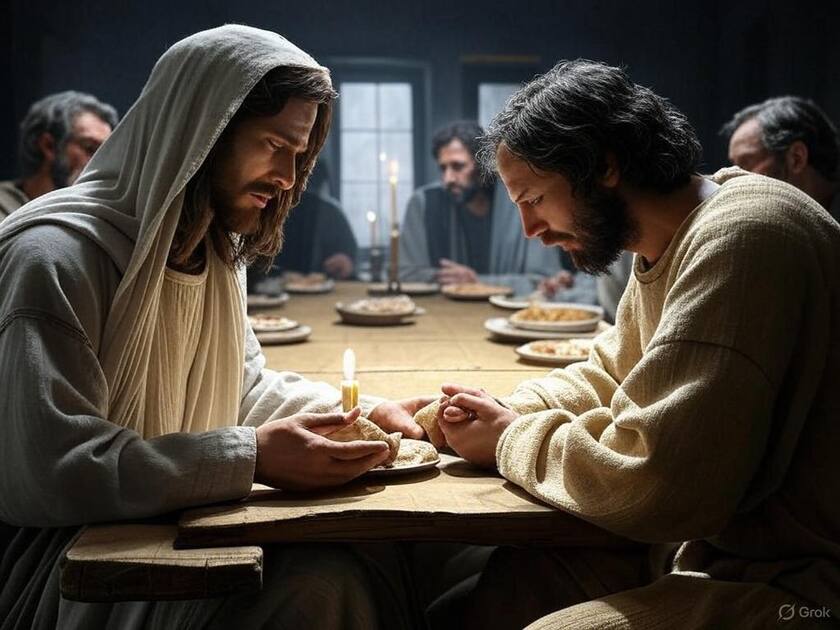One is Sacred and the Other Profane
Luke 22:1-2
"Now the Feast of Unleavened Bread drew near, which is called the Passover. And the chief priests and the scribes were seeking how to put him to death, for they feared the people."
For six days the Passover feast is celebrated. The tension is building as the Passover approaches in Jerusalem. In preparation the entire home is purged of any yeast. And Luke's gospel intertwines this time of remembrance for the Jewish people with the sinister plotting of the chief priests and scribes against Jesus. The leaders’ fear of the people adds another layer to this tension, showing their calculated caution even as they pursued their deadly intent. You could say that they saw Jesus as a kind of leaven that needed purging. Seeing Jesus as a kind of "leaven" in their eyes, something they believed needed to be removed to preserve their order and authority, flips the symbolism on its head: while yeast traditionally represents sin or corruption, Jesus, the sinless one, becomes the target of their misguided purification efforts.
In Jewish tradition, yeast (or leaven) symbolized corruption and sin, and its removal was a meticulous act of purification before Passover. The Passover, a time meant for liberation and remembrance of God’s deliverance, becomes the backdrop for this dark conspiracy. It’s almost as if the physical act of removing yeast from homes mirrors their calculated scheming, both meticulous, both aimed at control, yet one is sacred and the other profane.
Luke 22:3
"Then Satan entered into Judas called Iscariot, who was of the number of the twelve. He went away and conferred with the chief priests and officers how he might betray him to them. And they were glad, and agreed to give him money. So he consented and sought an opportunity to betray him to them in the absence of a crowd."
This sets Judas right in the thick of the sinister plotting against Jesus. Judas, like the religious leaders, seems to be caught up in a tangled web of motives. But Judas embodies a different kind of corruption, one driven by betrayal. In John's gospel, it hints that Judas had a love for money (he managed the disciples’ funds and pilfered from them). In Matthew 26:15 we're told that Judas went to the Chief priests and said, "What will you give me if I deliver him over to you?" And they paid him thirty pieces of silver. And so, his motives seem clear. If yeast represents sin, Judas doesn’t purge it from himself, instead, he lets it fester, opening the door for Satan’s influence. While the chief priests were cautious, and calculating how to act without sparking a revolt, Judas moves in secret, conspiring away from the crowds and even his fellow disciples.
I think Judas thought more of the group, of the ministry, then the man Jesus. He held firm beliefs about what their impact and image should be among the Jewish people. And he had grown more and more uncomfortable with what Jesus was saying and doing. I think he was looking to purge Jesus from their ministry like purging leaven. It's hard to imagine that someone could see sin in the things that Jesus did, but I think in his mind Judas believed Jesus was an offense to their larger program. I think Judas wasn’t just driven by greed or a vague malice, but by a distorted vision of the overall group’s mission.
It’s almost like he’s projecting his own corruption onto the one who’s actually sinless. It's like he's blaming Jesus for making him steal money from the group and for betraying him. It’s hard for us to fathom someone seeing sin in Jesus’s actions, like healing on the Sabbath or dining with sinners, yet Judas and the Chief priests viewed these things as reckless, offensive, or even a betrayal of their faith. Maybe he thought Jesus’s increasing talk of suffering and death (like in Luke 9:22) clashed with the triumphant, powerful ministry he envisioned. Judas had in mind all sorts of wonderful ministry moments that were now being put at risk by Jesus' seemingly reckless disregard for the temple and the Jewish tradition.
Judas now sees Jesus as the source of his unease, Jesus is the one throwing everything off balance. He's thinking and acting like a man possessed by demons. Luke 22:3 explicitly says, "Then Satan entered into Judas." It’s as if his festering discontent, his greed, his dashed hopes, his projection of blame, creates an opening for something darker to take hold of him. He’s not just projecting his corruption onto Jesus now; he’s spiraling into a state where his thoughts and actions align with a demonic agenda.
If yeast is sin, Judas doesn’t just let it fester, he lets it overtake him, like dough rising out of control. Jesus, who’s been breaking bread with sinners and teaching mercy, becomes the scapegoat for Judas’s unease, the one "throwing everything off balance." Maybe Judas felt the ministry should’ve been a clean, triumphant rise to power, and Jesus’s insistence on humility, suffering, and confrontation with the temple felt like chaos he couldn’t stomach.
Possessed by this distorted lens, he acts to purge Jesus, not seeing that he’s the one truly unbalanced. It’s almost as if Satan amplifies Judas’s human flaws, his frustration, his need for control; turning him into a tool against the One fulfilling God's Passover promise.
Some see Judas as a pawn, I do not. He is very deliberative in his calculations. His greed, his arrogance, his discontent are all leaven that is growing and thriving in him because he's a sinful corrupted person. He's a deliberate actor in his own downfall. He's leaven unbridled, thriving in him because he’s cultivating it in his corrupted heart.
Luke 22:4-6 shows him seeking out the chief priests, negotiating the deal, and looking for the right moment to hand Jesus over, all moves that feel intentional, not impulsive. Satan entering him, is not an excuse; it’s a consequence. His arrogance convinces him he knows better, his greed seals the deal, turning his betrayal into a transaction he justifies to himself. This makes him less a victim of circumstance and more a mirror to the chief priests; both calculating, both trying to purge Jesus as a perceived threat, and both blind to the true Passover unfolding before them.
Ironically, or paradoxically, his deliberate sin becomes part of a bigger purpose he can’t grasp. His corruption doesn’t derail God’s plan; it unwittingly serves it, delivering the Lamb to the cross.
And as they ate the Passover meal, as Jesus breaks the bread and blesses the wine, he says,
Luke 22:21
"But behold, the hand of him who betrays me is with me on the table."
Amid the intimacy of this sacred supper, betrayal sits at the table. Judas, with all his deliberative corruption, his greed and discontent thriving like leaven, is right there, hands on the same table, eating the same meal. It’s a stark collision of the holy and the profane, the purging of sin through Jesus’s sacrifice and the festering of sin in Judas’s heart.
Jesus knows. He’s not blindsided by Judas’s calculations or the yeast that’s overtaken him. It’s almost as if Jesus is laying bare the contrast: this meal, this bread and wine, will become symbols of redemption, while Judas’s presence signals the need for that redemption. It’s a profound contrast, right there at the table, grace and betrayal, sacrifice and sin, all tangled up in this one meal. Jesus lays bare the human condition: even at the Passover, even with the Lamb in their midst, corruption festers. It’s not a surprise to Jesus; it’s the very reason he’s there.
No doubt Judas hearing Jesus’s words causes a feeling of anger to flare up in him, provoked by the reality that Jesus is omnipresent, the Messiah who sees right through him and his schemes. He's exposed by Jesus' words and bristling at Jesus’s omniscience, maybe resenting that his carefully laid plans, his hidden leaven, aren’t hidden at all. It’s like Jesus is peeling back the mask Judas has worn, and rather than repent. This was Judas' moment, his point of no return. He could have repented right then and there, begged forgiveness for his crimes. A true prodigal moment. But he doesn't.
Imagine it: Jesus knows Judas’s heart, knows the anger, the defiance, and still shares the meal with him, still offers the bread and wine that will symbolize redemption. Meanwhile the table is silent, the bread still in hand, the wine blessed, and Judas could’ve broken down, confessed his crimes, and found mercy right there.
The one who knows his thoughts could’ve washed his sins away. But he doesn’t. He doubles down, letting that anger fuel his resolve, choosing the path of betrayal over the path of grace. The yeast has won, he's gone too far now to turn back.
Now we can truly understand the gravity of the heavy burden of unrepentant sin, the millstone of vice that weighs on the heart. It’s like you can feel the gravity of it; his greed, his anger, his hardened resolve all piling up, dragging him down when he could’ve been set free. That image from Luke 17:2, where Jesus speaks of a millstone hung around the neck of one who causes others to stumble, feels eerily apt here, except Judas’s vice isn’t just harming others; it’s drowning him too. He’s at the table with the one who could lift that burden, yet he clings to it, letting it sink him deeper.
Judas is a truly tragic man. A fool. A thief. A miserable deceitful cheat. And he's going to sell out his King with a kiss and an embrace. And yet Jesus loved him.
It’s a brutal portrait, and yet it’s all true. And the moral of the story is that Christ's love doesn’t flinch, even as the knife’s already in his back. Judas is a fool to miss it, a cheat to trade it for silver, but Jesus’s love doesn’t waver.
Amen.




















